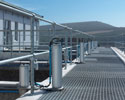

According to Statistics South Africa’s quarterly labour force survey, the economically active population for the first three months of 2010 is 17 million out of a potential 31 million within working age. However, we still sit with a skills shortage as less than 2 million are employed trades people, and approximately 2% of this number is skilled in the utility, gas and water supply industry (Quantec 2007). There are too few qualified persons with water and wastewater plant experience to handle the growth in the utilities market.
The economic growth determined by producer price index (PPI) for South Africa has followed a steady upward trend during the period 2000-2010 (Stats SA). PPI growth for the water and gas industry has naturally followed, but at a slightly steeper rate. This indicates an increasing demand for water and gas, which has to be compensated by an increase in production and supply capacity. Confirming this, the Department of Water Affairs predicts a 4-6% growth in water consumption in South Africa over the next few years. Stats SA’s 2010 annualised gross domestic product estimate is 4,6%.
Two important points emerge:
* Additional capacity for water treatment has to be constructed to compensate for the growth in demand.
* The number of skilled persons required to maintain and operate the plants is not growing at the required rate.
Do we sink or do we automate?
Plant automation is becoming increasingly important, but automation generally requires higher skilled personnel to maintain and repair the equipment. This may seem like a paradox, but with the correct design and a few basic steps complexity can be minimised.
Firstly, ensure designs are simple to enable easy inspection and equipment change. This also empowers less skilled labour to be trained to perform general tasks on the plant. Secondly, ensure reliable remote diagnostics for fault finding; this has the added benefit of using scarce skilled labour more effectively. Remote diagnostics also feed back important information for preventative maintenance programmes to function effectively. Thirdly, keep the working components close to the application and centralise the brains of the operation. This ensures that the controlling components are kept in a safe working environment and are protected from accidental mechanical damage during day-to-day operations.
Recently, Festo commissioned a portion of Kleinbrak, a 15 Ml/day water treatment plant, where these design principles were followed and achieved through electro-pneumatic control. Starting with the air supply, a piston-type compressor was used with a primary and standby compressor pump to ensure reliability of supply through redundancy. The air cleaning units follow a dual stage process, removing 40 μm and 5 μm dust particles to ensure longevity of the pneumatic equipment. A refrigeration dryer was installed to remove water and ensure the system stays relatively condensate-free.
As additional precautions the air reticulation system was designed to ensure airlines all angled towards a single drainage point for residual condensation occurring in the system, and are manufactured from a UV and corrosion-resistant polyamide for maintenance free operation.
The valve terminal is situated in a central, yet easily accessible control cabinet close to the main air reticulation line and communicates directly with the controlling PLC using a fieldbus connection. The valve is capable of collecting and transmitting remote I/O data and in the same terminal can actuate the pneumatics using onboard solenoids for each process valve in the required sequence. The system is completely modular and has the added benefit of built-in diagnostics. This design and construction ensures that the terminal can be maintained and repaired with ease and also assists with fault finding and data collection via a single bus system.
To regulate the flow rate of raw water into the plant, an integrated linear actuator is used to control the sluice gate. The actuator is unique as all the controlling components are housed inside and it has an IP75 rating. This reduces external mechanical connections and ensures longevity and functionality.
By using good electro-pneumatic design for this project, Festo says it has:
* Simplified the design and installation through centralisation of valve terminals.
* Used technologically advanced equipment and minimised complexity through modularity.
* Improved the performance monitoring process of equipment through reliable diagnostics, and ensured longevity and high corrosion protection for application in corrosive outside conditions.
* Managed the scarce skilled operating and maintenance labour resource more effectively and empowered lesser skilled resources to be trained for day-to-day operation and maintenance of the plant.
For more information contact Joanne Dexter, Festo, +27 (0)11 971 5560, [email protected], www.festo.com
| Email: | [email protected] |
| www: | www.festo.co.za |
| Articles: | More information and articles about Festo South Africa |

© Technews Publishing (Pty) Ltd | All Rights Reserved